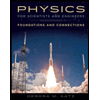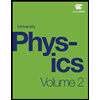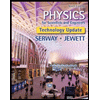Assuming that a cloud of electrons confined in a region between two spheres of radii 1 cm and 3 cm has a charge density of: (0.0003cos2theta)/R2 Coulomb/m3 Find the total charge contained in the region
Assuming that a cloud of electrons confined in a region between two spheres of radii 1 cm and 3 cm has a charge density of: (0.0003cos2theta)/R2 Coulomb/m3 Find the total charge contained in the region
Principles of Physics: A Calculus-Based Text
5th Edition
ISBN:9781133104261
Author:Raymond A. Serway, John W. Jewett
Publisher:Raymond A. Serway, John W. Jewett
Chapter19: Electric Forces And Electric Fields
Section: Chapter Questions
Problem 14CQ
Related questions
Question
100%
Assuming that a cloud of electrons confined in a region between two spheres of radii 1 cm and 3 cm has a charge density of: (0.0003cos2theta)/R2 Coulomb/m3
Find the total charge contained in the region
Expert Solution
This question has been solved!
Explore an expertly crafted, step-by-step solution for a thorough understanding of key concepts.
Step by step
Solved in 4 steps with 4 images

Knowledge Booster
Learn more about
Need a deep-dive on the concept behind this application? Look no further. Learn more about this topic, physics and related others by exploring similar questions and additional content below.Recommended textbooks for you

Principles of Physics: A Calculus-Based Text
Physics
ISBN:
9781133104261
Author:
Raymond A. Serway, John W. Jewett
Publisher:
Cengage Learning

Physics for Scientists and Engineers: Foundations…
Physics
ISBN:
9781133939146
Author:
Katz, Debora M.
Publisher:
Cengage Learning


Principles of Physics: A Calculus-Based Text
Physics
ISBN:
9781133104261
Author:
Raymond A. Serway, John W. Jewett
Publisher:
Cengage Learning

Physics for Scientists and Engineers: Foundations…
Physics
ISBN:
9781133939146
Author:
Katz, Debora M.
Publisher:
Cengage Learning


Physics for Scientists and Engineers, Technology …
Physics
ISBN:
9781305116399
Author:
Raymond A. Serway, John W. Jewett
Publisher:
Cengage Learning